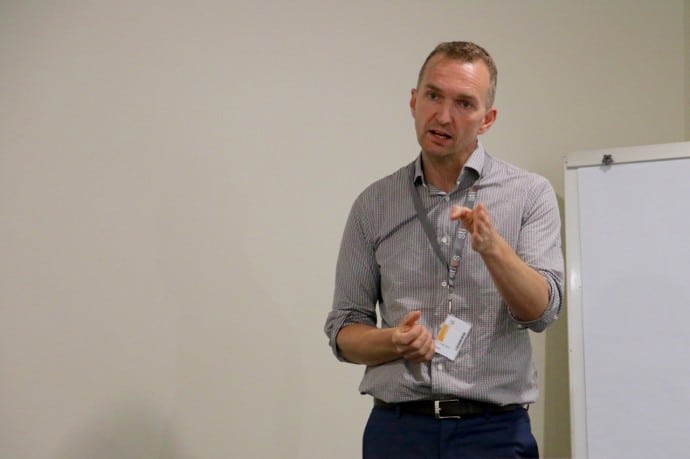Band aids that monitor body functions and assist in diagnosis; medical packaging that measures temperature; electronic pain killers and devices that stop epileptic seizures; and, plants and paper that can conduct and store electricity. It sounds vaguely like science fiction but these are the challenging areas that electronic engineers and material scientists are working on right now.
“It comes down to whether you can bridge signalling between electronics, humans and plants,” according to Magnus Berggren, Professor of Organic Electronics at the Laboratory of Organic Electronics, Division of Physics and Electronics, Linköping University and current STIAS fellow.

Berggren and his colleagues, together with engineers of RISE Acreo, are exploring organic electronics as the signalling bridge between biological systems and electronics and, by doing so, are targeting new opportunities in diagnostics, therapy and biotechnology. The work encompasses artificial nervous systems, electronic plants and power papers, and therefore has applications from medical diagnoses and treatment to the search for green energy technologies for the future.
At the simplest level, the group has been successful in printing electronics on flexible surfaces, e.g. paper and plastics, which is used to create smart labels containing electrical circuits for medical packaging that can measure things like temperature change. “We are working closely with Médecins san Frontières (Doctors without Borders) on this,” said Berggren. “Much of their work is in vaccine delivery and often in rural settings in warm climates – being able to know if the vaccines are safe in terms of temperature and therefore that the cold chain is maintained is essential.”
Similar printed electronics make it possible to develop band aids that can measure physiological parameters present in body fluids like saliva and sweat, temperature, stress hormones and infection indicators, and thus monitor medical conditions. “Such band aids can be used for long-term monitoring but also for quick triage and screening in emergency situations,” said Berggren.
“Basically we are putting printed electronics either onto or into the body to record bodily functions. This could have a good impact on skyrocketing health care costs.”
“Using the coupled charge accumulation and ion exchange of conjugated polymer-polyelectrolyte systems different sensor and actuator devices have been developed,” said Berggren. “Included in circuits, these can simultaneously record and regulate physiology and functions at high speed and resolution.”
Combating chronic pain and seizures
“Such circuits have also successfully been applied, in vivo, to combat pathological pain and epileptic seizures in tissue and animal models,” said Berggren. “Basically it’s about creating an artificial nervous system, adding a parallel neuronal network.”
“Chronic pain is very hard to treat,” added Berggren. “Our first response to pain occurs in the spinal cord not the brain and it is this area that we are targeting. Our synapses both receive and transmit signals. We need to mimic this and to create electronic devices that will run faster than the signals in our body and enable the direct delivery of exact-dose pain killers. Basically an electronic pain killer.”
“Other uses include delivering chemicals very quickly at the exact point of seizure for epilepsy and stimulating sensitivity in the cochlear to control hearing volume,” continued Berggren. “Taking a pill to prevent an epileptic seizure can take up to 20 minutes. We are hoping to be able to suppress a seizure within seconds. Thus far this work is only in animal and pre-clinical studies and still a long way from human studies, but it is promising.”
“In the longer term we are working with mobile company Ericsson to make these devices communicate with each other and with external devices like laptops.”
‘We believe this work could have a major impact in assisting people with long-term neurological diseases and conditions.”
Electronic plants and power papers
The group is also looking at the possibility of plants conducting electricity and the development of paper-based supercapacitors.
“Plants are very different to humans with most of their constructs based on cyclic structures and signals. However, digital organic circuits have successfully been achieved, applied to, and manufactured inside the vascular systems of plants, for example in Rosa floribunda – the common rose,” said Berggren. “This could open the door for new ‘green’ energy technologies but also allow electronic control over the growth and production processes in living plants.”
“The idea would be to add an artificial neuronal system into the plant to improve its functionality like delaying flowering and controlling growth rates. Hopefully you would be able to develop a system that will replace genetic modification in plants.”
“It might also be possible to turn the leaves of plants into solar cells,” he added.
Another area of ongoing work is investigating the possibility of developing energy storage capacity in paper. Even where solar power is used, the challenge is to store electricity for cloudy days – this is where supercapacitors are used for storage and fast release.
“However,” said Berggren, “the cost, physical properties and eco-unfriendly characteristics of present supercapacitors hamper the development of future all-electric technology in our society.”
“There is a need for ‘green’, low-weight and low-cost supercapacitor technology,” he added.
If you can develop electrical circuits in paper as the group has done in electronic labelling and band aids, it is obviously possible to do this on a much larger scale. “We are investigating the development of high-performing supercapacitors, which can be manufactured using traditional paper manufacturing and printing technologies – Power Papers – that may eventually also be able to store electricity,” said Berggren. “It’s obviously an area of high interest to the forestry industry.”
Finally, Berggren said: “Science does not run on air! We are very grateful to the national and international agencies and foundations that have financially supported our science over the years, especially the Knut and Alice Wallenberg Foundation, VINNOVA and SSF (the Swedish Foundation for Strategic Research).”
A summary of Magnus Berggren’s STIAS project is available here.
Michelle Galloway: Part-time media officer at STIAS
Photograph: Christoff Pauw
